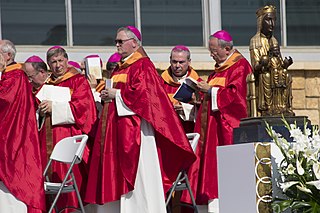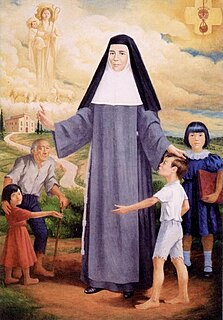
The Order of Friars Minor Capuchin is a religious order of Franciscan friars within the Catholic Church, one of Three "First Orders" that reformed from the Franciscan Friars Minor Observant, the other being the Conventuals. Franciscans reformed as Capuchins in 1525 with the purpose of regaining the original Habit (Tunic) of St.Francis of Assisi and also for returning to a stricter observance of the rule established by Francis of Assisi in 1209.

The 108 Martyrs of World War II, known also as the 108 Blessed Polish Martyrs, were Roman Catholics from Poland killed during World War II by Nazi Germany.
The Martyrs of the Spanish Civil War are the Catholic Church's term for the people killed by Republicans during the Spanish Civil War for their faith. More than 6,800 clergy and religious were killed in the Red Terror. As of February 2022, 2,069 Spanish martyrs have been beatified; 11 of them being canonized. For some 2,000 additional martyrs, the beatification process is underway.

José María of Manila is a Spanish Filipino Roman Catholic blessed, and was priest of the Order of Friars Minor Capuchin. He was martyred in the early phase of the Spanish Civil War, and is the third Filipino to have been declared blessed by the Roman Catholic Church.

The 498 Spanish Martyrs were victims of the Spanish Civil War beatified by the Roman Catholic Church in October 2007 by Pope Benedict XVI. It was the greatest numbers of persons ever beatified at once up to that time in the Church's history. They originated from many parts of Spain. Their ages ranged from 16 years to 78 years old. Although almost 500 persons, they are a small part of the Martyrs of the Spanish Civil War.

Angela of the Cross Guerrero y González, was a Spanish religious sister and the foundress of the Sisters of the Company of the Cross, a Roman Catholic religious institute dedicated to helping the abandoned poor and the ill with no one to care for them. She was canonized in 2003 by Pope John Paul II.

The 522 Spanish Martyrs were victims of the Spanish Civil War beatified by the Roman Catholic Church on 13 October 2013 by Pope Francis. It was one of the largest number of persons ever beatified in a single ceremony in the Church's 2000-year history. They originated from all parts of Spain. Their ages ranged from 18 to 86 years old.

Peregrina Mogas Fontcuberta was a Spanish Roman Catholic nun in the name of "María Ana" and the founder of the Franciscan Missionaries of the Mother of the Divine Shepherd. Mogas Fontcuberta was in a Capuchin congregation before establishing her own order and was under the guidance of Josep Tous Soler.

Fidela Oller Angelats was a Spanish Roman Catholic professed religious and professed member from the Religious Sisters of Saint Joseph of Girona. Oller was born to potters and lived her life in her town until she set herself on entering a religious order. But the premature death of her father forced her to return home to tend to her mother and brothers though she later returned to the order for her profession and religious life. Oller moved from place to place in service to her order and rendered her assistance to the ill in hospitals where she was known for her attentiveness and comfort.
Institutional and societal calendars of the Roman Rite of the Catholic Church are lists of saints' feast days and other liturgical celebrations, organized by calendar date, that apply to members of individual institutes of consecrated life and societies of apostolic life of pontifical right that worship according to the Roman Rite of the Latin Church. They are "particular calendars" that build off of the General Roman Calendar.







